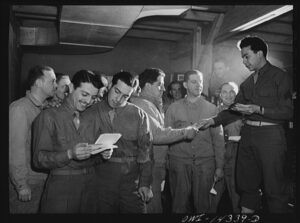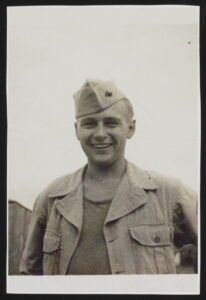In 1943, as the Second World War raged, seasoned war correspondent Milton Bracker reported from North Africa on a troubling trend affecting American servicemen. Writing for the New York Times Sunday Magazine, Bracker began with a simple truth: “Separation” was the defining factor in the lives of most during wartime. However, the comforting adage “absence makes the heart grow fonder” often proved false. In places like Algiers, among weary soldiers, “Dear John clubs” were emerging – informal support groups for men who had received devastating letters from home.
Bracker described the typical “Dear John” letter as something along these lines:
“Dear John: I don’t know quite how to begin but I just want to say that Joe Doakes came to town on furlough the other night and he looked very handsome in his uniform, so when he asked me for a date…”

GI slang for a letter ending a relationship – a breakup note from a girlfriend, fiancée, or wife – the “Dear John” letter quickly entered popular American lexicon in 1943. The term has remained relevant through decades of conflicts, becoming a recurring motif in stories of military service. From fictional characters like Gomer Pyle to the relatable Radar O’Reilly of M*A*S*H, and from soldiers in Vietnam to those in the Gulf War, the “Dear John” letter has become an almost expected part of the uniformed experience in the USA.
The Elusive “Dear John” Letter: An Oral History
Despite their prevalence in wartime narratives, physical “Dear John” letters are incredibly rare in archives. While researching the phenomenon for my book, Dear John: Love and Loyalty in Wartime America, I searched extensively for these letters, but my efforts proved fruitless. Unlike cherished love letters from home, “Dear John” letters were seldom kept. Understandably, a rejection letter is not something most people would preserve for posterity.
However, this scarcity led to a crucial realization: the “Dear John” letter is better understood not as a written genre, but as a male oral tradition. Conversations with experts at the American Folklife Center were instrumental in this shift in perspective. Our understanding of these infamous letters largely comes from the stories told by servicemen and veterans about these breakup notes and the women who wrote them. Thanks to the diligent work of Megan Harris, a senior reference specialist, I explored over a hundred oral histories from the Veterans History Project, each containing a “Dear John” story, sometimes briefly mentioned, sometimes as a central, impactful anecdote.
Variations in “Dear John” Stories: More Than Just Breakups
One of the most surprising discoveries was the sheer variety within “Dear John” stories. Even the definition of a “Dear John” letter isn’t universally agreed upon by veterans. Some insist it’s not just a breakup letter, but one that cruelly informs the recipient that he has been replaced by another man. The identity of this replacement often becomes a key element of the story’s impact. During World War II, the rival was often a 4-F (someone exempt from service); sometimes, it was a close friend or even a relative. The 1953 hit song, “A Dear John Letter,” by Jean Shepard and Ferlin Husky, released as the Korean War armistice was signed, featured the heartbreaking twist of John being replaced by his own brother, Don. Veteran Gerard Streelman’s story takes this a step further, eliciting laughter even amidst the seriousness of the topic.
[Illustrated envelope sent by Sumner Grant to his fiance, Helen. Sumner Grant Collection, Veterans History Project, AFC2001/001/20970.Streelman’s anecdote follows a somber account of a suicide triggered by a “Dear John” letter, which he recounts to his son, the interviewer. This juxtaposition of tragedy and comedy highlights the genre’s flexibility. “Dear John” stories aren’t simply tales of grievance or heartbreak; they encompass the full spectrum of wartime experiences, ranging from deeply traumatic to surprisingly humorous.
Veterans like Streelman also recall profoundly disturbing instances of young men taking their own lives after receiving a “Dear John.” Sam Sachs, interviewed at the remarkable age of 102, vividly recounts a suicide from World War II, an event so impactful it felt as if it had just occurred. Interestingly, Sachs doesn’t condemn the woman who broke off the relationship. He acknowledges her youth, loneliness, and desire for connection – emotions shared by many young men in uniform stationed far from home.
Coping and Payback: Male Responses to “Dear Johns”
However, not all veterans are as forgiving. One recurring theme in “Dear John” narratives is the creative ways servicemen sought to reclaim agency and get the “last word” in a situation where they felt powerless, facing a life-altering decision made in their absence. Arthur Taylor, who served with the Third Army in World War II, devised an elaborate scheme to guilt-trip his former girlfriend into believing he was in mortal danger during the Battle of the Bulge. Claude Orville Bryant, another World War II veteran, shares a story, echoed by veterans of later conflicts, about a “Dear Johned” buddy who gathered photos of other men’s girlfriends, sent them to his ex, and quipped, “I haven’t seen you in a long time I forget what you look like.”

Beyond the Letter: Discovering Breakups in Other Ways
For some, the “Dear John” letter never arrived. Instead, they learned of their replacement indirectly, often after returning home. Theodore Cummings, a Marine Corps veteran of WWII, received a newspaper clipping from his mother informing him of his girlfriend’s marriage to another man while he was overseas. Jim Wayne, a Marine who served in Vietnam for thirteen months, returned to discover his high school sweetheart had married someone else. The news was delivered by her father, Lafayette, Indiana’s first Black police officer, when Wayne eagerly knocked on their door. The experience of receiving a “Dear John,” or its equivalent, transcended racial lines, becoming a shared aspect of the American military experience.
The Wider Impact: Dear Johns and the Military Community
Beyond personal heartbreak, the impact of “Dear John” letters rippled through the military community. Dr. Theodore Ning, a medic in Vietnam, describes his expertise in counseling distressed, often intoxicated, servicemen grappling with the emotional fallout of “Dear Johns.” Nurses like Ilsa Hansen Cooper, also serving in Vietnam, recount providing emotional support to distraught men, sometimes dealing with self-inflicted wounds. Interestingly, female veterans also remind us that they too received letters ending relationships while deployed – “Dear Jane” letters. Toby Newman, interviewed in 2015, recounted being casually dumped by her boyfriend while serving in the Women’s Army Corps with the dismissive words, “You wanted to be free, now you’re free.” Remarkably, unlike most male veterans and their discarded “Dear Johns,” Newman had kept her “Dear Jane” letter, a tangible symbol of a less recognized wartime wound.
Unexpected Outcomes: Dear Johns and New Beginnings
Decades later, some veterans reflect on “Dear John” letters as unexpected turning points, heralding improved romantic prospects. These breakups, initially painful, ultimately freed them from unsuitable relationships, paving the way to find their true partners and decades of marital happiness. Perspective shifts with time. However, Kenneth Brown’s story offers a different kind of unexpected outcome: a life potentially saved by a “Dear John.” His elaborate story, one of the most compelling in the Veterans History Project, underscores the unpredictable role of fate in even the most perilous circumstances.
Like fate itself, Dear John letters could operate in mysterious ways, leaving an indelible mark on the lives of American servicemen and the broader wartime experience in the USA.
Interested in learning more about Dear John letters? Watch a video interview with Dr. Carruthers and VHP Reference Specialist Megan Harris here.

